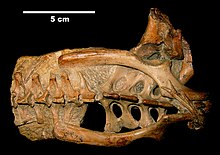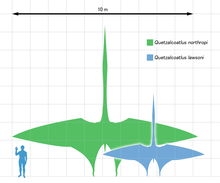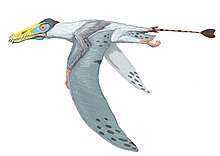Pterosaurs
| Pterosaurs | ||||||||||||
|---|---|---|---|---|---|---|---|---|---|---|---|---|
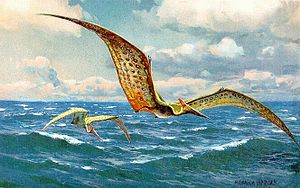
Pteranodon , representation by Heinrich Harder (1916) |
||||||||||||
| Temporal occurrence | ||||||||||||
| Carnian ( Upper Triassic ) to Maastrichtian ( Upper Cretaceous ) | ||||||||||||
| 235 to 66 million years | ||||||||||||
| Locations | ||||||||||||
|
||||||||||||
| Systematics | ||||||||||||
|
||||||||||||
| Scientific name | ||||||||||||
| Pterosauria | ||||||||||||
| Kaup , 1834 |
The Flugsaurier (Pterosauria) are extinct reptiles , approximately simultaneously with the dinosaurs lived and how these same to the group of Ornithodira within the Archosauria included. Thanks to their large, wing-like flight membranes, they were the first vertebrates to be able to fly actively. The birds and bats developed their ability to fly later and each independently.
The earliest finds of pterosaurs go back to the lower Upper Triassic ( Carnian ) about 228 million years ago. They were present on earth until the great mass extinction at the turn of the Cretaceous to the Paleogene ( Cretaceous-Paleogene boundary ) about 66 million years ago.
Two types of pterosaurs are distinguished: The "long-tailed pterosaurs ( Rhamphorhynchoidea )", which are characterized by a long tail and relatively short metacarpal bones , were the earliest forms and disappeared in the Upper Jurassic . The short-tailed pterosaurs (Pterodactyloidea), which had no or only a very short tail and long metacarpal bones, appeared in the Middle Jurassic and died out at the end of the Cretaceous Period. This classic classification is no longer used in taxonomy , since the short-tailed pterosaurs descend from the long-tailed pterosaurs. The long-tailed pterosaurs are therefore a paraphyletic group in terms of the phylogenetic system .
Way of life
Locomotion


An important question about the way of life arises regarding the flight ability of the pterosaurs. It is generally assumed that especially the small species could actively fly very well. The large pterosaurs of the Cretaceous, on the other hand, were probably primarily glider pilots who, like birds of prey , were dependent on the updraft , or dynamic gliders who, like the albatrosses , used horizontal winds of different speeds in the lee of wave troughs to cover long distances with as little energy as possible get over with. The maritime way of life speaks in favor of dynamic gliding, as there are no updrafts over the sea, and the high wing extension of many species. But even these animals had to be able to take off actively and gain altitude at least out of the water.
Precisely because of the high expenditure of energy that is necessary to fly, it is now usually assumed that the animals were warm-blooded and largely hairy. This is also supported by the discovery of the hairy Sordes pilosus ("hairy devil") and hair-like prints in other pterosaur fossils from the Solnhofen limestone and the Posidonia slate from Holzmaden .
Since the hind legs of the pterosaurs were only very small, the question arises as to how the animals could move on land. To answer this question, two alternative theories are discussed. According to Kevin Padian and Jeremy Raynor , the animals used their legs like today's birds and walked bipedally. They attribute this to the fact that the legs are built similarly to those of today's birds and were therefore probably used in a similar way. David Unwin and Peter Wellnhofer assume instead that the pterosaurs walked four-legged (quadruped) and used their arms (like today's vampire bats ), whereby the wing finger was beaten backwards. They assume that the membranes also include the hind legs. The latter theory is currently the preferred one. Investigations of the pelvic structure of Annexuera and Campylognathoides have shown that the pterosaurs could not place their hind legs vertically under the body and that the large pterosaurs in particular could only have moved very heavily on their hind legs alone. So far, however, we are not sure about this.
It is also possible that different types use different solutions here. So it is easy to imagine one of the smaller, long-tailed forms on the hind legs, but rather difficult with the large and largest forms of the late Cretaceous period.
Diet, Habitat and Reproduction
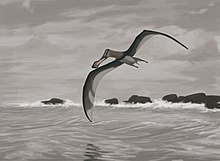
The pterosaurs were probably all hunters and carnivores. The early long-tailed pterosaurs hunted mainly for fish and squids and lived on the coast of the sea or other large bodies of water. An indication of this are the very long and trap-like teeth, which could be used perfectly for packing and holding fish. The animals probably lived together in larger colonies similar to today's breeding colonies of sea birds. Later small pterosaurs were very likely also insect hunters. A very unusual pterosaur called Pterodaustro from South America had very long and extremely thin teeth that formed a trap. He used it to filter seawater and feed on plankton like today's flamingos .
Although most of the fossils of pterosaurs have so far come from habitats in larger bodies of water, it is now undisputed that many species also lived inland, for example in forests, mountains or even deserts. The lack of fossil evidence is due to the very poor fossilization conditions of these habitats and the very thin bones of the animals.
Pterosaurs, like all archosaurs, were egg-laying animals. A find published in 2004 of a fossil embryo from the early Cretaceous period about 121 million years ago, which comes from the Liaoning province of northeast China, is impressive evidence of this. The egg found was slightly smaller than a hen's egg and contained a well-preserved skeleton, along with impressions of skin and wing tissue. The already existing wing span of 27 centimeters in the animal, which was presumably about to hatch, is taken by the discoverers as an indication that the young animals were probably early developers who were able to fly shortly after hatching and were able to feed independently of their parents .
The fact that pterosaurs lived together in colonies, on the other hand, is primarily based on theoretical assumptions as well as on a find in the Atacama Desert in Chile, where a large number of remains of young pterosaurs were found in a very small space.
anatomy
Anatomy of the wings
The most striking feature of the pterosaurs are their front legs, which have been transformed into large wings, which have enabled the animals to glide as well as active flight. Here, the stretched wing membrane between the body of the animals and the arm with the greatly elongated fourth finger of the animals, which corresponds to the ring finger at the people on. The other three fingers formed claws outside the flight membrane, the fifth finger was missing.
The wing bones of the pterosaurs were usually hollow and very thin-walled. They contained lots of air-filled areas so that the weight of the bones would not become too heavy. The ends of the larger bones in particular were reinforced by trabeculae. As a rule, only fragments of the wing bones are found for this reason; intact bones are extremely rare. The wing bones of the two pterosaur forms differ significantly.
The wing of the long-tailed pterosaur consists of a very short upper arm bone (humerus) and a relatively short metacarpal bone . The four finger bones, however, are quite long. The claws are also on very short metacarpal bones. The forearm is like all vertebrates of two bones, the ulna (ulna) is slightly longer than the radius (radius). In cross-section, almost all bones in the shaft area are oval, while they become heart-shaped towards the ends.
In contrast, in the short-tailed pterosaurs, both the upper arm and the ulna are more massive and longer, the spoke is just as long as the ulna, only less thick. The metacarpal bones in particular are much longer than those of the earlier pterosaur forms, while the fingers are correspondingly shorter in relation to the other bones. Short-tailed pterosaurs also usually had four finger bones. The claws are very well developed and also end on elongated metacarpal bones. The bone wall is thinner than that of the long-tailed pterosaur and thickens towards the end of the bones. The cross section is hollow and triangular and becomes oval towards the end. These features are particularly noticeable in the very large forms.
The wings themselves consisted of a skin structure that was reinforced by closely spaced fibers, so-called actinofibrils, thus ensuring stability of the wing on the one hand and resistance to tearing on the other. These structures could be examined on the well-preserved flight skins of some pterosaurs from the Santana formation.
Spine
The spine of the pterosaurs differs significantly from the earlier reptiles and is adapted to the flying way of life and the associated demands on the axial skeleton. In some areas it was very similar to the bird's spine ( convergence ) with a pronounced shoulder region and a massive region in the pelvic area . The back was only very short and accordingly allowed only a few movements, the longest area was the cervical spine , accordingly most of the individual finds of vertebrae are cervical vertebrae.
The cervical spine is very long compared to other vertebrates. The neck consists of eight vertebrae in the early pterosaurs, while some of the larger late forms have reduced the number to six. The first two vertebrae of this section, the atlas and the axis , were mostly fused into a single vertebral bone. The bony wall of the vertebrae was thin, and the interior consisted of spongy bone framework with large air spaces. Neck ribs did not normally exist.
The thoracic spine consisted of up to twelve vertebrae, with most species having fewer. The first vertebrae were mostly fused into a massive shoulder structure to which the shoulder blades (scapulae) attached. In some species this formed a long bone that extended over six to eight vertebrae.
The back spine consisted of about six vertebral bodies and was very short but compact. Like all other vertebral bones, they were also filled with entablature, but they also had a large hole on the side, which completely penetrated the bone. In most species, these vertebrae had short abdominal ribs .
The sacral or lumbar spine was usually fused into one massive bone with which the pelvic bones were closely associated. In the early long-tailed pterosaurs this structure was still relatively loose, but in the short-tailed pterosaurs it was a single pelvic bone. There were usually six to eight vertebrae in this area.
The caudal spine in the long-tailed pterosaurs was very long and could consist of more than 35 caudal vertebrae. Some of these pterosaur fossils have a sail print at the end of the tail, this probably served for navigation and stabilization in flight. In the short-tailed pterosaurs, the number of tail vertebrae has been reduced to a small number.
Skull and teeth
The pterosaur skull, like other parts of the skeleton, resembled that of birds, largely due to the various savings and reductions that made the skull lighter. The main difference, however, concerns the dentition, which was particularly well developed in the early pterosaurs. The most massive structures, and thus those that appear most frequently among fossil finds, were the tips of the jaws and the base of the jaw at the quadratum .
An essential feature of the pterosaurs is a ring made of bone plates that was around the eye and whose biological meaning has not yet been clearly clarified. It probably served as a pressure compensation element. Furthermore, like all other archosaurs, the animals had a third skull window in front of their eyes (prefrontal window), while they had reduced the temple window. Many of the short-tailed pterosaurs had high and long skull crests, which, depending on the interpretation, served to amplify sound and / or stabilize flight.
The teeth are also very often preserved in fossil form, however, especially in the late Cretaceous period, there were a number of species that had no or only very small teeth. The earliest pterosaurs had multi-pointed teeth (usually with three points: tricuspid teeth), which were replaced by long and pointed teeth, for example in Rhamphorhynchus . These teeth protruded beyond the edge of the mouth in the long and thin jaws. However, some of the long-tailed pterosaurs had no teeth at all.
During the Upper Jurassic, the number of teeth in pterosaurs decreased. Some species still retained teeth at the front end of their jaws, while others lost all of their teeth, creating a beak-like jaw. The large pterosaurs of the late Cretaceous all had no teeth.
Discovery story
Like the dinosaurs , the pterosaurs belonged to the animal groups that aroused enormous fascination when they were first discovered. Pterosaur fossils are among the first ever found fossils of terrestrial vertebrates and were accordingly examined at the beginning of paleontological history in the early 19th century. The first description of a pterosaur comes from Cosimo Alessandro Collini in 1784 . Particularly well-preserved fossil finds from southern England and Germany made the pterosaurs popular both within scientific circles and among the people. Among the first finds were Dimorphodon macronyx , which was discovered by Mary Anning in the "Lias formation" near Lyme Regis , as well as Rhamphorhynchus and Pterodactylus from the late Jurassic, which were found in the limestone of Solnhofen . The finds led to them being described as the most wondrous creatures of the prehistoric world . In 1831, the German naturalist Georg August Goldfuß took the view that these animals looked more like they came from fantasy than from nature.
During the 19th and 20th centuries, the number of fossil finds increased and, most importantly, the group's biodiversity became more and more evident. The Plattenkalke in Solnhofen and Eichstätt in particular turned out to be very rich deposits of fossil pterosaurs. The very well-preserved Rhamphorhynchus longicephalus was discovered here in 1839 as the first pterosaur with a long and complete tail. Short-tailed animals, which obviously must have lived at the same time, were also discovered in the same layers. In England, the Wealden Formation was particularly rich in fossils of animals, which Gideon Mantell first described as birds (1822, 1827 and 1837) and who Owen recognized as belonging to the pterosaurs in 1846. Seeley assigned them to the genus Ornithocheirus . In 1870, Othniel Charles Marsh discovered the remains of the giant pteranodon in Kansas and thus the first pterosaur skeleton in North America. In 1895 Felix Plieninger introduced the division of pterosaurs into long-tailed pterosaurs and short-tailed pterosaurs, which was only revised in the last two decades by phylogenetic studies.
Also in the course of the 20th century the fossil finds and the well-known wealth of forms increased. In addition to the classic sites, there were others that document the worldwide distribution of the animals. Today there are particularly abundant sites in the Santana formation in Brazil , in Paki in Senegal and in northern China .
Triassic pterosaurs
The oldest pterosaurs come from the Upper Triassic and accordingly lived around 228 million years ago. Most of the representatives from this period only found bone fragments, complete skulls or skeletons are extremely rare. The early species can be recognized mainly by their teeth, which are equipped with several points. The teeth of later species have only one point and are long-oval. Furthermore, the bones of the early pterosaurs are more massive and have a thicker outer layer, while the inside has less open spaces.
|
Pterosaurs from the Triassic:
|
|---|
All pterosaurs of the Triassic and early Jurassic had long tails, and most early pterosaurs are characterized by very long teeth, such as Rhamphorhynchus from the Solnhofen limestone.
Probably the best preserved skeleton of an early pterosaur is Eudimorphodon ranzi . The specimen comes from the limestone of Cene near the northern Italian city of Bergamo . In the stomach area, remains of the last meal were found in the form of fish scales . Obviously this species was a fish eater .
The Eudimorphodontidae play an essential role at the beginning of the evolution of the pterosaurs, from them the first representatives of the Dimorphodontidae and the Rhamphorhynchidae developed in the Triassic. These two taxa are still present in the Jurassic period, while the Eudimorphodontidae disappeared at the end of the Triassic.
Most and the most complete finds of the Triassic come from Italy: from the Zorzino limestone near Cene in Lombardy and from the Preone Valley in the Alps.
Pterosaurs of the Jurassic
In the Jurassic period there were great evolutionary changes in the pterosaurs. They spread worldwide and colonized many different habitats. The long-tailed pterosaurs of this time mostly had long teeth that narrowed sharply towards the tip. Some species had notched teeth, but most had smooth teeth.
|
Pterosaurs from the Jura
|
|---|
The long-tailed pterosaurs disappeared around the middle of the Jura. They were replaced by the short-tailed pterosaurs or Pterodactyloidea, which emerged from a subgroup of them at the beginning of the Jurassic. These had largely reduced the tail and in their evolution show a shortening of the teeth and an elongation of the metacarpal bones on the flight skin-bearing finger.
In the course of the Jura, the pterosaurs developed into a very successful group of vertebrates. In the early and middle Jurassic period, further taxa of the long-tailed pterosaurs emerged exclusively from the Dimorphodontidae and Rhamphorhynchidae with the Scaphognathinae, Campylognathoides and Rhamphocephalidae, which were already known in the Triassic.
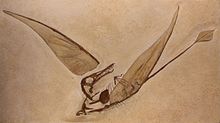
It was not until the later Jurassic that the untailed pterosaurs, mainly represented by the Pterodactylidae, played a major role. At this time there was the greatest biodiversity of the pterosaurs overall, they colonized the most diverse habitats in all parts of the world.
The plate limestone near Eichstätt and Solnhofen , where the ancient bird Archeopteryx was found, is a very rich deposit for pterosaurs from the Jura . The conditions for fossilization in this material are extremely good, so that even some flight membranes and soft tissue impressions have been preserved. The skeletons of Rhamphorhynchus and Pterodactylus are among the finds in these plate limestones .
The Qaratai or Karatau Mountains in Kazakhstan are also regarded as excellent deposits of the Jura . For example, the apparently hairy Sordes pilosus with preserved wing membranes was found here.
Cretaceous pterosaurs
The largest forms of the pterosaurs developed in the Cretaceous period, at the same time giant forms of the dinosaurs and other animal groups ( plesiosaurs , mosasaurs , ichthyosaurs ) emerged. As already shown, these pterosaurs are exclusively short-tailed pterosaurs.
|
Pterosaurs from the chalk |
|---|
The large pterosaurs could be found all over the world, but there were still smaller forms. These smaller pterosaurs were likely to be in direct competition with the newly evolving birds, which were rapidly expanding at the time.
Until the 1970s, Pteranodon from North America was considered the largest pterosaur, its wingspan reached about eight meters. It was surpassed by the discovery of the Quetzalcoatlus (named after the Aztec god Quetzalcoatl , who was depicted in the form of a feathered serpent, among other things), which after extrapolating its skull dimensions and comparing it with other pterosaurs could have reached a span of up to 12 meters. Hatzegopteryx reached similar proportions from the European Upper Cretaceous, whose skeletal fragments discovered in the Romanian Hațeg Basin were only identified as pterosaur fossils in the late 1990s.
A very important deposit for pterosaur fossils of the Upper Cretaceous is the Araripe Basin in Brazil and here especially the layers known as the Crato Formation and the Santana Formation . Very different pterosaurs come from this area, including, for example, Appendixuera , Criorhynchus , Ornithocheirus , Tapejara , Thalassodromeus , Ludodactylus and Tupuxuara .
Another important site for pterosaurs from the Cretaceous period is Xinjiang in China, where important dinosaurs (including some feathered dinosaurs ) and mammals (such as Hadrocodium wui ) have been made. Among the pterosaurs , for example, Dsungaripterus wei and Noripterus complicidens come from this region, which are particularly noticeable because of their strong jaws. Similar to Solnhofen and the Crato formation , the finds from the Jehol group in Liaoning are characterized by “soft tissue preservation”. The Chinese species are similar to finds from Solnhofen as well as from Brazil . The findings from China so far suggest a similar, if not greater, diversity than there.
The Niobrara Limestone and other rocks in Texas and Kansas , where some of the largest of the known pterosaurs, such as Pteranodon ingens and Quetzalcoatlus , were discovered, are also considered to be rich . The bones of these animals are often very fragile and have been found widely scattered.
A reservoir for pterosaur fossils that has only recently been developed is the Ouled Abdoun Basin in northern Morocco (around 70 km from Casablanca ). The area is known for its rich and industrially usable phosphate deposits , which were formed during the transition from the Cretaceous to the Paleogene . In these layers, from individual bones to partial skeletons, over 200 pterosaur fragments were found, which belong to 3 families (Pteranodontidae, Nyctosauridae and Azhdarchidae) with a total of 7 species. All finds come from the late Maastrichtian with a temporal proximity to the Cretaceous-Paleogene border of at most one million years. This indicates that the biodiversity of the Pterosauria was essentially preserved at least in this region until the end of the Cretaceous.
Evolution of the pterosaur
The pterosaurs are very likely to descend from early archosaurs , who were also the ancestors of crocodiles and dinosaurs. The fossil record of the lineage of the pterosaurs is missing, accordingly this ancestry could only be proven by comparing the characteristics of the different animal groups. The skull structure of the pterosaurs can be seen as the main indicator. Like the other archosaurs, this one has a third skull window in front of the eye (pre-orbital window) and the vertex window (foramen parietale) is reduced. As further clues for classification, the pterosaurs have typical archosaur teeth and the fifth toe is reduced.
Within the archosaurs, the pterosaurs are probably the sister group of the dinosaurs, which are both placed together in the taxon Ornithodira due to the same structure of the ankles. The sister group relationship, however, is not so well founded and there are no conclusive common characteristics. The currently accepted family tree therefore corresponds to the following graphic:
| Diapsids |
|
||||||||||||||||||||||||
|
|
A fossil from the Scottish Lossiemouth is discussed as the closest relative of the pterosaurs and at the same time the dinosaurs . This animal, named as Scleromochlus taylori , shares some anatomical features with both groups. It could be particularly informative for the evolution of flight in the pterosaurs, since it is assumed that Scleromochlus taylori was a good jumper, who perhaps even had a preliminary stage of the pterosaur flight membranes. As early as 1914 Huene wrote about Scleromochlus : " ... it was a parachuting animal, which had skin duplications on the forelimbs, perhaps also in other places ." He assumed that the animal lived in the trees and used them as a jumping-off point for its gliding flight ( arboreal hypothesis).
The theory of the evolution of the pterosaurs from Scleromochlus- like precursors is specified by Michael Benton in 1999, who presents further options for the way of life of Scleromochlus taylori and, above all, offers a very detailed analysis of the animal's characteristics. In contrast to Huene, he favors the theory put forward by Woodward in 1907 that Scleromochlus was a jumper, but did not use trees as a jumping-off point, but was a ground runner with well-developed jumping ability (saltatory hypothesis). Accordingly, the first flying pterosaur is said to have developed from this type of jumper. So far it has not been clarified which of the two theories is correct, but it is exciting that the same theories were put forward for the evolution of flight in birds.
Systematics
The classic division of pterosaurs into two parts has been resolved by phylogenetic studies over the past 25 years. Accordingly, the short-tailed pterosaurs actually represent a natural systematic unit, but are embedded in the various groups that were previously combined to form the long-tailed pterosaurs. A number of families and other sub-taxa have been described, but most of them are poorly defined. The following is a cladogram of a possible internal system from a standard work by David M. Unwin:
| Pterosaurs |
|
||||||||||||||||||||||||||||||||||||||||||||||||||||||
|
|
A complete system with all genera can be found under systematics of pterosaurs .
literature
- Éric Buffetaut : Pterosaurs - Warmblood pioneers of the skies. In: Spectrum of Science . No. 11, 2004, ISSN 0170-2971 , pp. 24-31.
- Eric Buffetaut, Jean-Michel Mazin (Ed.): Evolution and Palaeobiology of Pterosaurs (= The Geological Society. Special Publication. Volume 217). The Geological Society, London 2003, ISBN 1-86239-143-2 .
- Michael Fastnacht: The first dsungaripterid pterosaur from the Kimmeridgian of Germany and the biomechanics of pterosaur long bones. In: Acta Palaeontologica Polonica. Volume 50, No. 2, 2005, ISSN 0567-7920 , pp. 273-288, online .
- Hartmut Haubold: Literature report: Pterosauria 2004–2008 (= Zentralblatt für Geologie und Paläontologie. Part 2: Paläontologie. Vol. 2009, Issue 1/2, ISSN 0044-4189 ). Swiss beard, Stuttgart 2009.
- David WE Hone, Eric Buffettaut (Eds.): Pterosaurs . Pterosaur papers in honor of Peter Wellnhofer (= Zitteliana. Series B: Treatises of the Bavarian State Collection for Paleontology and Geology. Volume 28, ISSN 1612-4138 ). Bavarian State Collection for Paleontology and Geology, Munich 2008.
- David M. Unwin: The Pterosaurs. From deep time. PI Press, New York NY 2006, ISBN 0-13-146308-X .
- Peter Wellnhofer : Pterosauria (= Handbook of Paläoherpetologie. Volume 19). Pfeil et al., Munich et al. 1978, ISBN 3-437-30269-8 .
- Peter Wellnhofer: The great encyclopedia of the pterosaurs. Illustrated natural history of the flying dinosaurs. 100 species. Mosaik-Verlag, Munich 1993, ISBN 3-576-10174-8 .
- Peter Wellnhofer: Illustrated Encyclopedia of Pterosaurs. Crescent Books, New York NY 1991, ISBN 0-517-03701-7 .
Web links
- Pterosaur.net (English)
- The Pterosaur Database (English)
- Pterosaur Site (German)
- Pterosauria Translation and Pronunciation Guide ( Memento of October 13, 2011 in the Internet Archive )
- The Pterosaur Species List ( Memento from September 30, 2011 in the Internet Archive ) (English, PDF, 789 kB)
Footnotes
- ↑ Animated wireframe model of Appendixuera santanae (Walking)
- ^ Peter Wellnhofer: Illustrated Encyclopedia of Pterosaurs. 1991, pp. 76-77 and 126.
- ↑ Xiaolin Wang, Zhonghe Zhou : Palaeontology: Pterosaur embryo from the Early Cretaceous. In: Nature . Volume 429, No. 6992, 2004, p. 621, doi : 10.1038 / 429621a .
- ↑ David Michael Unwin, D. Charles Deeming. Prenatal development in pterosaurs and its implications for their postnatal locomotory ability. Proceedings of the Royal Society B: Biological Sciences, 2019; 286 (1904): 20190409 DOI: 10.1098 / rspb.2019.0409
- ↑ At that time still described under the name Pterodactylus macronyx , see William Buckland: On the discovery of a new species of pterodactyle in the Lias at Lyme Regis. In: Transactions of the Geological Society of London. 2. Series, Volume 3, Part 1, 1829, pp. 217–222 ( BHL )
- ↑ Nicholas R. Longrich, David M. Martill, Brian Andres: Late Maastrichtian pterosaurs from North Africa and mass extinction of Pterosauria at the Cretaceous-Paleogene boundary . In: PLOS Biology . March 2018. doi : 10.1371 / journal.pbio.2001663 .
- ↑ Classification of reptiles in: Michael J. Benton : Paläontologie der Vertebreltiere. Translation of the 3rd English edition by Hans-Ulrich Pfretzschner. Pfeil, Munich 2007, ISBN 978-3-89937-072-0 , p. 419 f.
- ↑ Michael J. Benton: Scleromochlus taylori and the origin of the pterosaurs. In: Philosophical Transactions of the Royal Society London. Series B: Biological Sciences. Volume 354, No. 1388, 1999, ISSN 0080-4622 , pp. 1423-1446, doi : 10.1098 / rstb.1999.0489 , digitized version (PDF; 576.33 kB) .
- ↑ David M. Unwin: The Pterosaurs. From deep time. 2006, p. 228.
- ↑ Junchang Lü, David M. Unwin, Xingsheng Jin, Yongqing Liu, Qiang Ji: Evidence for modular evolution in a long-tailed pterosaur with a pterodactyloid skull. In: Proceedings of the Royal Society. Series B: Biological Sciences. Volume 277, No. 1680, 2010, ISSN 0950-1193 , pp. 383-389, doi : 10.1098 / rspb.2009.1603 .



